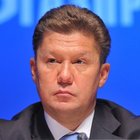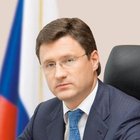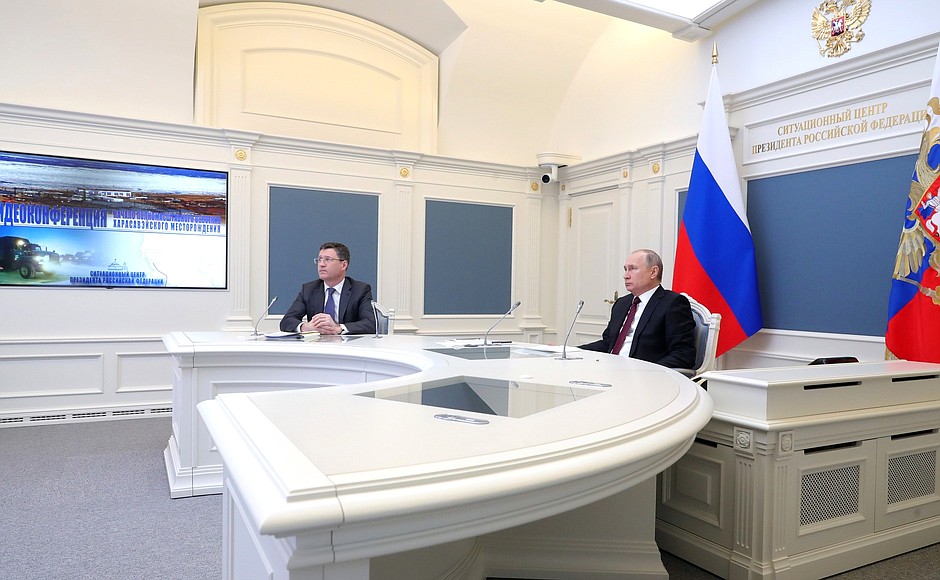
The Kharasaveyskoye field is located in the Yamal Peninsula north of the Bovanenkovskoye field, predominantly onshore and partly in the Kara Sea. The field is classified as unique due to its enormous gas reserves, which amount to 2 trillion cubic meters. Production is scheduled to begin at the field in 2023 with a design capacity of 32 billion cubic meters of gas per year.
Since 20 percent of the reserves are located offshore, horizontal wells will be drilled from onshore to produce gas from the offshore part of the deposit.
The project provides for the construction of a comprehensive gas treatment unit, a booster compressor station and clusters of producing gas wells together with transport and energy infrastructure.
Kharasaveyskoye already has a utility system with accommodation for shift workers and an auxiliary power station.
* * *
Videoconference of the launch of the full-scale development of the Kharasaveyskoye gas and condensate field
President of Russia Vladimir Putin: Mr Miller, friends, colleagues,
Today we are launching a new and very challenging Gazprom project: the full-scale development of the Kharasaveyskoye gas and condensate field in the Yamal Peninsula. I congratulate all of you on this landmark achievement and wish you every success in implementing this ambitious project. In fact, we are making one more step towards the comprehensive development of Yamal and the creation of a modern and powerful gas production and processing centre there.
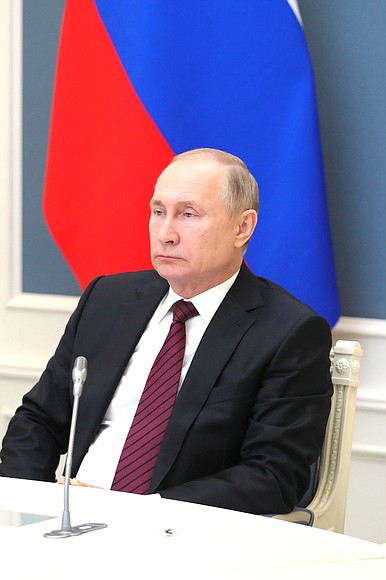
Much has been done towards this goal. Late last year, gas production at the Bovanenkovskoye field reached design capacity. Novatek is successfully implementing its LNG projects. Production facilities, accommodation for shift workers, gas pipelines and transport infrastructure have been built. It is notable that the development of these areas continues.
The development of the Kharasaveyskoye field will open up new prospects for the energy sector, strengthening our export potential and the capability for connecting new users to the gas supply system in Russia, as well as for boosting the national economy as a whole. The field has enormous reserves – nearly 2 trillion cubic metres of gas. Together with the Bovanenkovskoye field, we have 7 trillion cubic metres of gas there. It is a huge reserve. As Gazprom CEO Alexei Miller has told me, these reserves will last until 2131. Taking into consideration that all the gas reserves in the Yamal Peninsula exceed 16 trillion cubic metres, we will be able to work there for decades. These are reserves on a global scale. Just to show you what this means: the Kharasaveyskoye field has more gas than the throughput capacity of one Nord Stream line. These huge reserves for years ahead guarantee the safety and security of energy supplies to the customers both in the country and to our partners abroad, as I have said.
Of course, there is hard, challenging work ahead to develop the field. But I am confident that our professionals will achieve all these goals in the best possible manner, especially since we have accumulated considerable experience when it comes to the implementation of such large-scale projects.
I would like to wish you good luck with your endeavours and all the very best.
Please.
Gazprom CEO Alexei Miller: Mr President,
We are now in the accommodation area for the shift workers at the Kharasaveyskoye field. It was here back in 1974 that the first well was drilled, which today supplies gas to the control flare and provides heat and electricity to the small gas workers’ settlement. Today we would like to honour the pioneers. They have lived and worked here in very difficult conditions. We suggest watching a video about the history of the Kharasaveyskoye field.
(Video shown.)
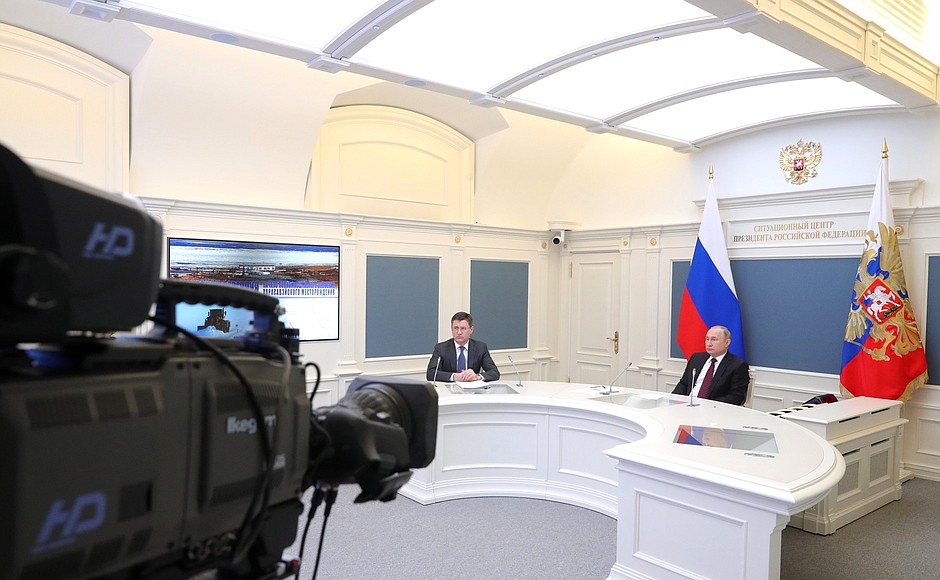
Mr President, Gazprom is ready to begin full-scale development of the Kharasaveyskoye field. We have direct connection with Director General of Gazprom Dobycha Nadym Sergei Menshikov, who will report on the readiness for launch.
Vladimir Putin: Go ahead please, Mr Menshikov.
Sergei Menshikov: Mr President, Mr Miller,
Director General of Gazprom Dobycha Nadym Sergei Menshikov reporting here. I am at the Bovanenkovskoye oil and gas condensate field, at gas production unit No.3. After its launch in December of last year, the Bovanenkovskoye field reached its target production level. Kharasaveyskoye is going to be next. In less than three months, we have built a temporary motorway – a winter road that connected Kharasaveyskoye and Bovanenkovskoye. Its length is over 100 kilometres, and today the first batch of construction and auxiliary equipment will be delivered along this main road.
Alexei Miller: Mr President, please give the go ahead for moving the machinery from the Bovanenkovsky field to the Kharasaveyskoye field.
Vladimir Putin: Go ahead.
Sergei Menshikov: Attention! Convoy to start towards the Kharasaveyskoye field.
There are more than 30 units of equipment in the convoy – bulldozers, tipper lorries, excavators, pipe layers, heavy lorries, personnel vehicles and a welding unit. All this equipment is necessary to launch start-up production at the Kharasaveyskoye field according to the plan for 2019.
The equipment is delivered along the winter road. The main difference between winter roads and permanent roads is that winter roads have no roadbed filling; therefore, it is lower than the average ground elevation. It is more difficult to drive on because of such natural obstacles as snowdrifts and blizzards. This explains the strict safety requirements for winter road traffic. For example, vehicles are only allowed to move on winter roads in organised trains.
The training of drivers is also important. These are usually top professionals with extensive experience of working in the Extreme North. We have calculated that the aggregate northern service record of the drivers who are working at the Kharasaveyskoye field is over 400 years.
The winter road laid for the field crosses six bodies of water, across which we have created ice crossings. We have installed special markers with light reflectors and rescue equipment on each ice crossing. The speed limit on ice bridges is 5 km/h. The average speed of the snow train today will be about 20 km/h.
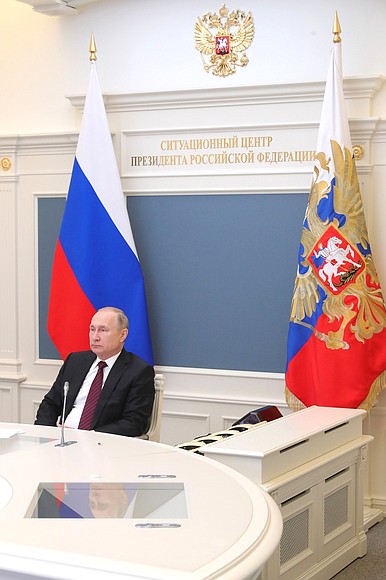
There will be two maintenance stops at warming centres on the winter road. The estimated time for reaching the Kharasaveyskoye field is eight hours.
This concludes my report.
Alexei Miller: Mr President, the project to develop the Kharasaveyskoye field will involve 5,500 construction workers and 2,000 units of equipment, the sinking of 236 wells, the use of six fifth-generation domestically produced Yekaterina drilling rigs, which have been working effectively and reliably at the Bovanenkovskoye deposit, as well as a heavy-duty Bentec rig.
It should be said that 20 percent of the Kharasaveyskoye reserves are located offshore, which is why horizontal wells will be drilled from onshore to produce gas from the offshore part of the deposit. In other words, Gazprom is launching the development of the Yamal shelf.
Seeking to optimise costs, it has been decided to align the design solutions for the Kharasaveyskoye project with those that have been already applied at the Bovanenkovskoye field. I am referring to a comprehensive gas treatment unit with a capacity of 32 billion cubic metres and the 150MW booster compressor station.
It has to be emphasised that only domestically produced equipment will be used at the Kharasaveyskoye field. A 106-kilometre gas pipeline will be built to ship gas from Kharasavey. It will be 1,400 millimetres in diameter. This pipeline will go through Bovanenkovskoye and then on to the Bovanenkovskoye-Ukhta gas mainline.
The project to develop the Kharasaveyskoye field is expected to last 108 years, which means that gas extraction will continue in Kharasavey up until the year 2131.
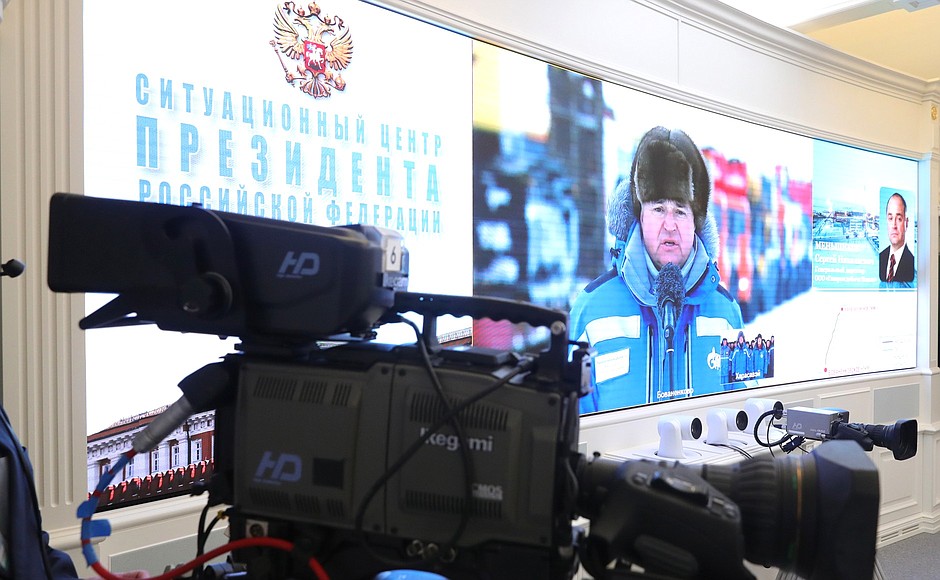
If you look behind me, you can see Gazprom’s advance team, including welders, installation workers, drillers, excavator operators and electricians. These are our most reliable workers. There is no doubt that these people can deliver on any task.
Mr President, Gazprom has launched the full-scale development of the Kharasaveyskoye field.
Vladimir Putin: Thank you.
Mr Novak, go ahead please.
Minister of Energy Alexander Novak: Mr President,
Allow me to report that the launch of the full-scale development of the Kharasaveyskoye gas and condensate field fully conforms to Russia’s strategy for the gas sector, as well as the master facility layout. The launch of this large-scale project in the Arctic also fully conforms to the project’s licensing life. Once operational, it will offset output reductions in the Nadym-Pur-Tazovsky region, and is also expected to produce additional volumes for export and domestic markets.
The Russian Government introduced additional incentives in 2014 for the development of the Arctic region, including amendments to the Tax Code for stimulating the development of Arctic gas fields. This includes mineral extraction tax breaks: the tax burden will be reduced by 80 percent during the first few years and will be gradually increased over a period of 12 years.
This is a large-scale project that will serve as an additional development driver for the entire Arctic region. Thank you.
Vladimir Putin: Friends, we all know that by the year 2030 Yamal’s gas output will have reached 310 bcm – 360 bcm that will be supplied to domestic and export markets, along the Nord Stream 1 and Nord Stream 2 pipelines. This will require monumental efforts and promises a lot of interesting work ahead. Congratulations to all of you on the launch and I would like to wish you all every success.
Thank you very much.
